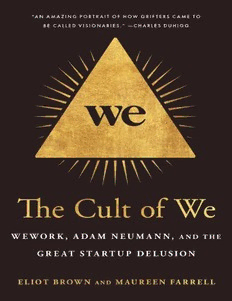
The Cult of We PDF
Preview The Cult of We
Copyright © 2021 by Eliot Brown and MMF Creative Inc. All rights reserved. Published in the United States by C , an imprint of ROWN Random House, a division of Penguin Random House LLC, New York. C and the C colophon are registered trademarks ROWN ROWN of Penguin Random House LLC. Hardback ISBN 9780593237113 International Edition ISBN 9780593239759 Ebook ISBN 9780593237120 crownpublishing.com Cover design: Lucas Heinrich ep_prh_5.7.0_c0_r0 Contents Cover Title Page Copyright Epigraph Authors’ Note Prologue: The Summit Part I Chapter 1: The Hustler Chapter 2: Greenhorns Chapter 3: Famous Energy Chapter 4: Physical Facebook Chapter 5: Manufacturing Community Part II Chapter 6: The Cult of the Founder Chapter 7: Activate the Space Chapter 8: Me Over We Chapter 9: Mutual Fund FOMO Chapter 10: Bubbling Over Chapter 11: Catnip for Millennials Chapter 12: Banking Bros Chapter 13: Taking Over the World Part III Chapter 14: Friends in High Places Chapter 15: It’s Tricky Chapter 16: One Billion Dollars per Minute Chapter 17: Neumann & Son Chapter 18: Crazy Train Chapter 19: Revenue, Multiple, Valuation Chapter 20: Community-Adjusted Profit Chapter 21: Adam’s ARK Chapter 22: The $3 Trillion Triangle Chapter 23: Summer Camp Chapter 24: Shoes Off, Souls Inside Chapter 25: Flying High Chapter 26: Both Mark and Sheryl Chapter 27: Broken Fortitude Part IV Chapter 28: Diseconomies of Scale Chapter 29: Guitar House Chapter 30: The Plunge Before the Plunge Chapter 31: To the Energy of We Chapter 32: Twenty to One Chapter 33: WeWTF: The S-1 Sh*T Show Chapter 34: A Setting Son Chapter 35: Paranoia Chapter 36: The Fall of Adam Chapter 37: DeNeumannization Chapter 38: Bread of Shame Epilogue Photo Insert Dedication Acknowledgments Notes About the Authors Built into the speculative episode is the euphoria, the mass escape from reality, that excludes any serious contemplation of the true nature of what is taking place. —J K G , A Short History of OHN ENNETH ALBRAITH Financial Euphoria ’ AUTHORS NOTE T September 2019 was an HE IMPLOSION OF WEWORK IN astounding moment in business. Nearly $40 billion in value on paper vanished, virtually overnight, as the investment world woke up to the reality that America’s most valuable startup wasn’t a tech company but simply a real estate company—one that was losing more than $1.6 billion a year. Its charismatic, hard-partying CEO, once lionized as the archetype of the modern-day “visionary” startup founder, suddenly became a target for criticism, particularly for his self-enrichment. In the wake of the company’s sudden unraveling, investors lost money, and employees lost their jobs; the CEO left rich. As reporters covering the saga for The Wall Street Journal, we had seats at the forefront of this downfall, chronicling the company as it buckled, and unearthing new details that became part of the story of its collapse. Still, despite an extensive reporting effort at the time, we were left with countless key questions unanswered. At the story’s heart was a simple mystery. How did this happen? Why did some of the world’s top investors and bankers fall under the spell of this company? How did capitalism contort to view something so inherently simple— a company leasing real estate—as a disruptive tech startup valued higher than Fortune 500 companies like FedEx and Target? Was the WeWork story an outlier, or was it simply the most vivid example of a cultural rot that had formed within twenty-first-century entrepreneurial and investment culture? In these pages, we attempt to answer these questions. While much was clear in public view—WeWork’s CEO, Adam Neumann, raised too much money, set expectations too high, partied too hard, and, ultimately, flew far too close to the sun—a more complex tale lay in the underlying infrastructure that enabled the office subleasing company’s rise and fall. WeWork’s money trail led to the country’s top banks, to a Middle Eastern monarchy eager to transform its economy, to mutual funds hungry to get a piece of the Silicon Valley action. The trail led to an eccentric and insecure Tokyo tycoon who yearned to be taken seriously by the American technology elite. There was a whole system thirsting to believe in the vision of a messianic and charismatic founder and the profits he could seemingly deliver. It’s a story about the toxic brew of confirmation bias, fuzzy math, and hubris. It’s a story about what people will do when they are allowed to spend other people’s money with minimal oversight. Our portrait of the WeWork saga draws on interviews with more than three hundred individuals who have shared their time, knowledge, experiences, and materials. It includes interviews with former and current WeWork executives, staff, and board members; SoftBank staff; bankers, advisers, investors, landlords, rivals, friends and family members of the Neumanns; SoftBank CEO Masayoshi Son; and numerous others. The vast majority of these people spoke on the condition that we would not reveal their identities as sources, with many citing nondisclosure agreements they signed with WeWork or other parties involved.
